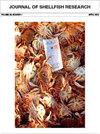牡蛎养殖河口鸟类的分类栖息地和潮汐利用情况
IF 1
4区 农林科学
Q3 FISHERIES
引用次数: 0
摘要
摘要 滨鸟在季节性迁徙过程中会利用各种潮间带河口栖息地休息和补充能量。鸟类可以在泥滩或沙滩、水生植被以及为贝类养殖而开发的潮间带觅食。华盛顿州是美国太平洋牡蛎(Crassostrea gigas)的主要商业产地,但有关海岸鸟类如何利用水产养殖栖息地以及周围海草和泥滩的研究却很少。在华盛顿州格雷斯港的一个牡蛎养殖场,通过摄影取样,研究了岸鸟和水鸟对泥滩、海草和延绳牡蛎养殖栖息地的利用情况。还评估了潮汐阶段(退潮期、枯水期或洪水期)的影响。研究人员确定了 13 个鸟类分类群,并分析了栖息地对群落组成和鸟类总丰度的影响,同时利用最常见的 6 个分类群分析了栖息地类型和潮汐阶段对分类群丰度的影响。在这六个重点类群中,黑腹鸻、美国乌鸦和大鸥(分别为 Pluvialis squatarola、Corvus brachyrhynchos 和 Calidris alpina)对栖息地类型有显著的响应--与鳗草和/或延绳钓有正相关关系,而大鸥、落羽鸥和海鸥(分别为 C. alpina、Limnodromus spp.和 Larus spp.)对潮汐阶段有显著的响应--与退潮期或洪水期有正相关关系。观察到的鸟类总数因生境和潮汐周期而异,在鳗草、退潮期和洪水期观察到的鸟类较多。在跨月取样时,栖息地类型对群落组成的影响不大。总体而言,各种岸鸟和水鸟类群都使用了所有三种生境类型,没有证据表明延绳钓养殖牡蛎对鸟类数量有负面影响。本文章由计算机程序翻译,如有差异,请以英文原文为准。
Taxon-Specific Habitat and Tidal use by Birds in an Oyster Culture Estuary
ABSTRACT Shorebirds use a variety of intertidal estuarine habitats to rest and refuel during their seasonal migrations. Birds can be found foraging on mud or sandflats, aquatic vegetation, as well as intertidal areas developed for shellfish aquaculture. In Washington State, which contributes substantially to commercial U.S. production of the Pacific oyster (Crassostrea gigas), little research has been published about how aquaculture habitats are used by shorebirds relative to surrounding seagrass and mudflat. Using photographic sampling, shore- and waterbird use of mudflat, seagrass, and longline oyster culture habitats was studied on an oyster farm in Grays Harbor, WA. The effect of the tidal stage (ebb, dry, or flood periods) was also evaluated. Thirteen bird taxa were identified and analyzed for effects of habitat on community composition and total bird abundance, whereas the six most common taxa were used in an analysis of habitat type and tidal stage effects on taxon abundance. Of the six focal taxa, black-bellied plover, American crow, and dunlin (Pluvialis squatarola, Corvus brachyrhynchos, and Calidris alpina, respectively) responded significantly to habitat type—having positive associations with eelgrass and/or longlines—whereas dunlin, dowitcher, and gulls (C. alpina, Limnodromus spp., and Larus spp., respectively) responded significantly to tidal stage—having positive associations with the ebb or flood periods. Total bird observations varied by habitat and through the tidal cycle, where more birds were observed in eelgrass and during ebb and flood periods. There was no strong effect of habitat type on community composition when sampling across several months. Overall, all three habitat types were used by a variety of shore- and waterbird taxa, with no evidence of a negative effect of longline oyster culture on bird abundance.
求助全文
通过发布文献求助,成功后即可免费获取论文全文。
去求助
来源期刊

Journal of Shellfish Research
生物-海洋与淡水生物学
CiteScore
2.30
自引率
0.00%
发文量
40
审稿时长
6 months
期刊介绍:
Original articles dealing with all aspects of shellfish research will be considered for publication. Manuscripts will be judged by the editors or other competent reviewers, or both, on the basis of originality, content, merit, clarity of presentation, and interpretations.
 求助内容:
求助内容: 应助结果提醒方式:
应助结果提醒方式:


